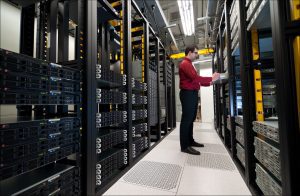Today we feature guest blogger, George Mitchell, IT Supervisor of Research and Development for Mobile (Ala.) County Public Schools. George writes about how school districts can respond to financial pressures by following four easy steps.
As U.S. public school systems budgets have remained flat or shrunk over the last few years, financial pressure to reduce costs has grown. How can educational institutions do more with less when the expectations of parents and scrutiny from governments are at an all time high? Something’s got to give.
Unfortunately for those in facilities, the burden to cut often lands on them, as it’s easier for administrators to make behind-the-scenes reductions versus eliminating student programs or faculty.
Even more unfortunate, the mandate for extra IT infrastructure efficiency may cause personnel to irresponsibly cut corners, resulting in damaged equipment and downtime. For example, shutting off uninterruptible power supplies (UPSs) for critical IT equipment or eliminating redundancy measures to save energy would leave systems susceptible to loss or damage via power disturbances.
The good news is that there are alternatives which can still lower cost without sacrificing continuity. Here are four easy steps.
- Virtualization and Server Consolidation
The traditional one-server-per-application approach meant that most servers in an IT environment were drastically underutilized — decreasing overall efficiency, wasting space and money. On the other hand, virtualization makes it possible to run multiple workloads on the same server, thereby increasing utilization and supporting consolidation of non-essential IT equipment. For example, decommissioning a single 1U rack server can save nearly $2,500 annually per rack.
- Cooling
Proper removal of heat is essential to operations. To ensure proper cooling functionality and avoid efficiency black holes make sure you have clear understanding of cooling basics such as airflow requirements, airflow in the rack cabinet, rack layout, distribution of loads and layout of air delivery and return. Adhering to best practices in cooling can result in dramatic savings since 99 percent of the electricity used to power IT equipment is converted into heat.
- Lithium-Ion Battery UPSs
Valve-regulated lead-acid (VRLA) batteries are still the dominant energy storage technology, but the use of Lithium-ion (Li-ion) batteries in UPSs is growing and worth considering to alleviate financial strain. Li-ion batteries are smaller in size and weight and have a dramatically faster recharge time. While they have a larger upfront cost, declining prices and longer life spans (nearly two times or more than traditional VRLAs) have made Li-ion batteries a viable option for realizing savings over the long haul. In fact, research has shown that Li-ion–based UPS systems have a total cost of ownership (TCO) that is 10 to 40 percent less (as of 2016) than that of a VRLA system over a 10-year period.
- Economizer Mode for UPSs
In eco-mode, found in most modern UPS systems, the UPS is operated at a reduced power protection in order to improve electrical efficiency and save energy. Findings from Schneider Electric note “a pickup of between 2 to 5 percent in UPS efficiency when eco-mode is used. (To be noted, in certain scenarios eco-mode can potentially effect reliability, and thus should be used with discretion.)
While many IT-specific budget-balancing measures may be unavoidable within the public school system, IT and facility managers should consider these approaches to reach increased efficiency and lower costs and mitigate risk.
Note: This blog was adapted from a contributed byline that first appeared in EdTech: Focus on K-12. For more details on the four ways you can improve efficiencies and reduce costs, read the original article.


